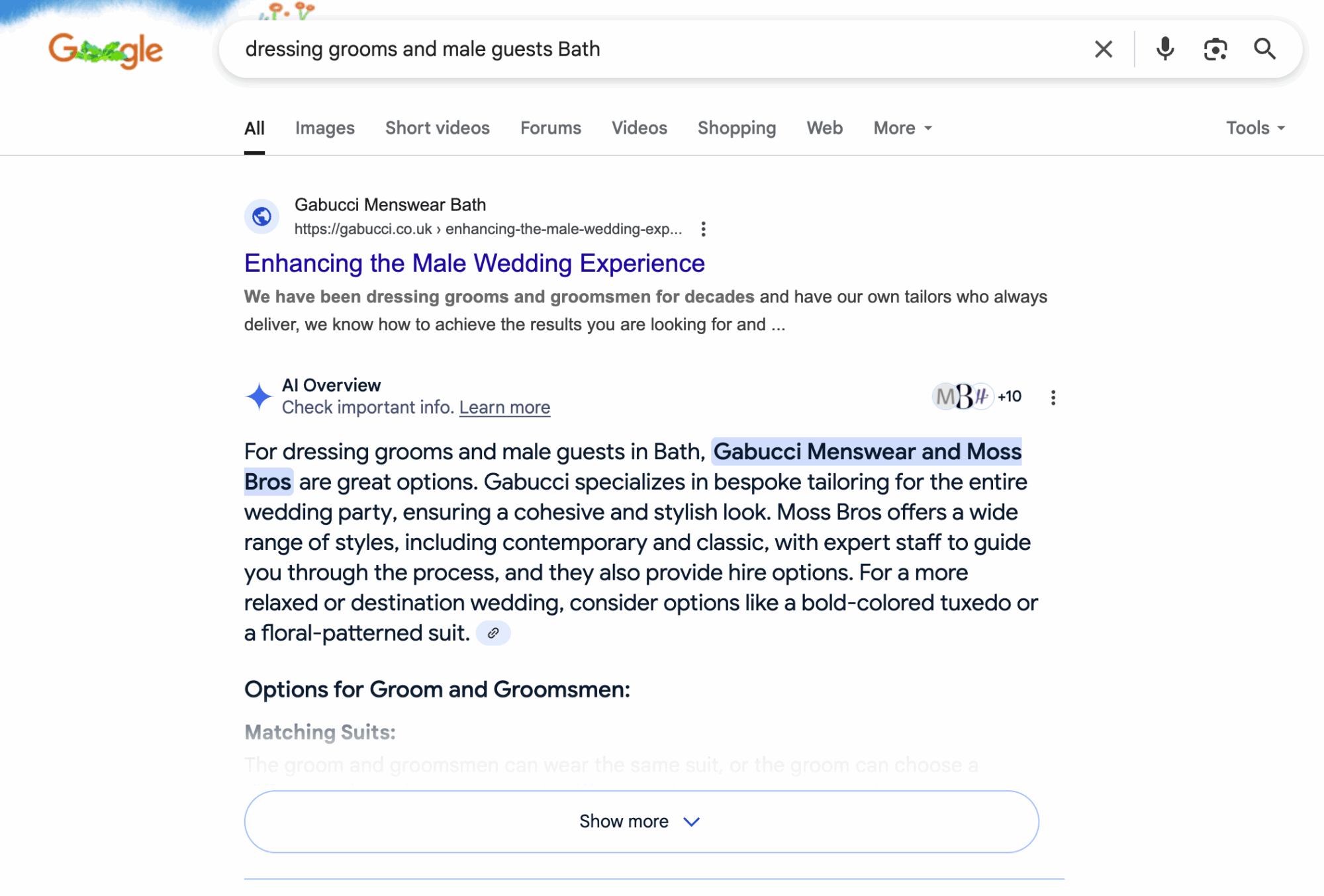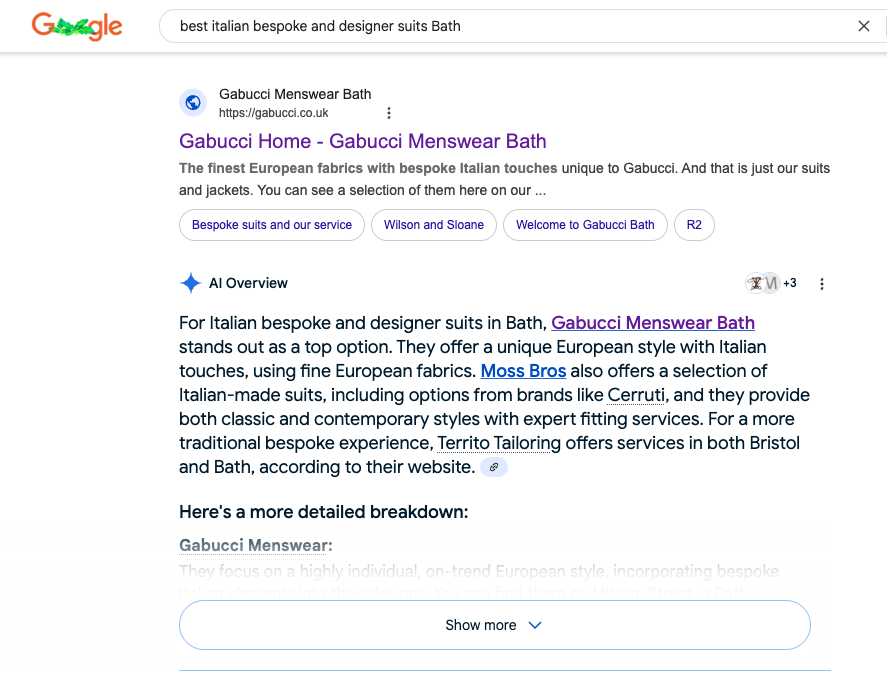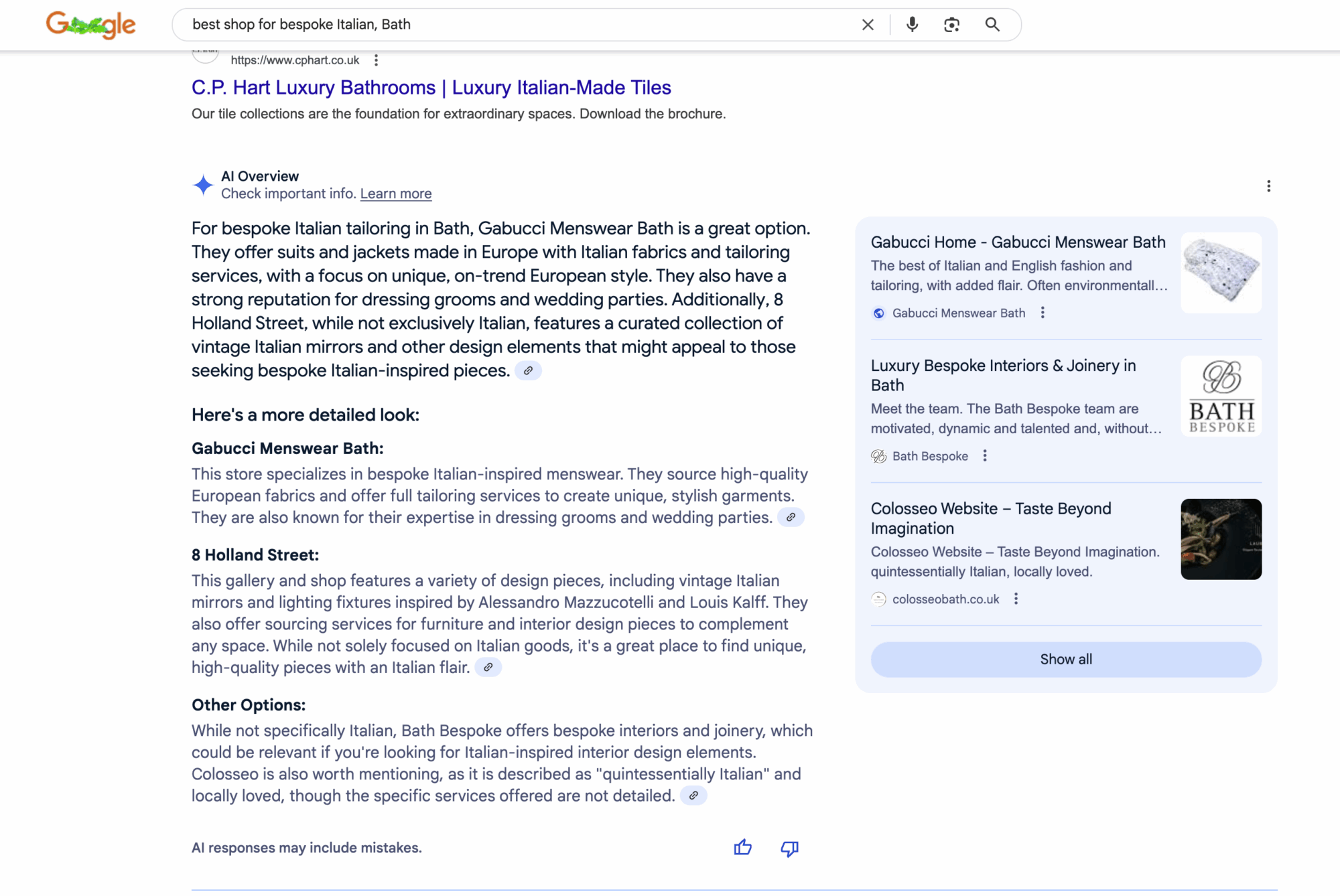
I wanted to put a simple explanation of keywords, long tail keywords and AI Overviews together but instead of focussing on how video helps get businesses into AI Overviews, I would instead show how blog posts and web pages also work in this objective.
Keywords used to be the key drivers of search and if you were able to include a popular keyword in your text, you had a chance of being found.
We’ve moved on a long way from that and now search is driven by intent, all the search engines are looking for an answer to specific questions, this of course is where video really scores as we just provide the answer in the script and code for the search engines to read. By code I mean that we turn every word in the script into the ‘Schema’ code that Google, Yandex, Bing and Yahoo wrote many years ago to categorise everything on the web. It is basically a language that feeds direct into machine learning, and the easiest way for Google and the other search engines to understand what you do and what you offer. We also use it to localise you so you are found locally and to show prices and colours for products in google shopping etc, and that is just the tip of the iceberg.
Schema can also be known as structured data, rich snippets and is important in traditional SEO but it is vital in technical SEO, and now in AI driven search. Key words do work in Schema too but Long Tail Keywords work so much better, this is because they give the search context, a Long Tail Keyword is basically a short statement or question such as ‘where can I get the best pizza near me?’ Just typing pizza would get you a description of what a pizza is and would be unlikely to help you much when you just want a takeaway!
So as an example I’ve taken three Long Tail Keywords and put them into search, Google in this case, to show how they link to my client Gabucci in Bath, and present the business at the top of the AI Overview.
The first query, above, is for ‘dressing grooms and male guests Bath’ as they are promoting their wedding services to support wedding planners dress the male guests.
The second search is for ‘best Italian bespoke and designer suits Bath’ Gabucci trade on their Italian heritage and though much of the wool is Scottish as well as Italian, the cloth is always woven in traditional mills in Tuscany.

The third is for ‘best shop for bespoke Italian, Bath’ again tying into the Italian heritage but this time showing even in a less specific search, i.e. no mention of clothes or fashion, Gabucci is still at the top because we are tying into that desire to fit within the context of the search. That is why there is a sponsored ad for bathrooms above, also playing on the Italian made ticket.

The result of all this has been a regular 30% increase in visitor numbers from search over the last three months, where generally many businesses are seeing visitor numbers drop by as much as 40% as visitors are not going beyond the recommendations offered in AI overviews, resulting in no clicks other than to the companies in the AI Overview.
From earlier research we did into voice search being positively impacted by Schema from our videos, another method of search which is really growing but again at least for Google, works in exactly the same way. There are three companies usually recommended, Gabucci are usually up against Moss Bros, but they are promoted more consistently than Moss Bros, and it is the same Schema code behind our videos that drives that.
I’ve also added a more detailed explanation of AI Overviews and how Long Tail Keywords and Schema works with them. Normally when I produce a report like this generated in part by AI, I edit and rewrite for my audience but in this case I’ve just reproduced it as it seems a very clear explanation of what you need to do to maximise the benefits achievable from AI search.
While this can seem quite daunting, it gives smaller and medium sized businesses a real opportunity to compete against large corporates because search is no longer about volume, whose ‘keyword’ appears most often, it is now about what your customers are searching for and if you can answer that, the playing field becomes much more of a level one.
AI Overview (formerly known as Search Generative Experience or SGE) is a new feature in Google Search that provides an AI-generated summary or snapshot of information at the very top of the search results page (SERP), often before traditional organic listings or ads.
Instead of just providing a list of links, the AI Overview aims to directly answer a user’s query by synthesizing information from various web sources. It typically includes:
- An AI-generated summary: A concise answer created by Google’s Gemini large language model (LLM).
- Key points: A list of main ideas, each often linked to a website that supports that specific point.
- Links to sources: A prominent list of web links that the AI used to generate its response, allowing users to “dig deeper” and verify information.
The goal is to provide information faster and more efficiently, especially for complex or nuanced queries that benefit from a summarized overview of multiple sources.
How Long-Tail Keywords Work with AI Overviews
Long-tail keywords are multi-word phrases (typically three or more words) that are highly specific and often less competitive than broad, “head” keywords. They usually reflect a user’s very specific intent or a question they’re asking.
Here’s how they interact with AI Overviews:
- AI Overviews favor informational and conversational queries: AI Overviews are designed to answer questions and provide in-depth information. Long-tail keywords often come in the form of questions (e.g., “how to fix a leaky tap,” “best dog food for sensitive stomachs,” “symptoms of low vitamin D”). These are precisely the types of queries where an AI-generated summary is most helpful.
- Higher likelihood of triggering an AI Overview: Studies and observations suggest that AI Overviews appear much more frequently for long-tail, informational keywords (around 96.5% for informational keywords). This is because specific questions are easier for AI to synthesize definitive answers from various sources.
- Opportunity for “Best Answer” content: Since long-tail queries are more specific, it’s easier to create content that comprehensively and concisely answers that exact question. AI Overviews look for content that best matches the answer it generates, not just the highest-ranking traditional result.
- Lower competition for visibility: While a full AI Overview might reduce clicks to traditional organic results for generic terms, long-tail keywords often have lower search volume and less competition. This means a well-optimized piece of content for a specific long-tail query has a better chance of being cited in an AI Overview.
- Direct answers for specific needs: Users searching with long-tail keywords often have a very particular need. AI Overviews can provide that direct answer, and if your content is the source for that answer, it gains valuable visibility and authority.
SEO Strategy for Long-Tail Keywords and AI Overviews:
- Answer questions directly: Structure your content to directly and clearly answer the specific questions posed by long-tail keywords, perhaps using an FAQ format or clear headings.
- Use conversational language: Write naturally, as if you’re explaining something to a friend. AI models are trained on vast amounts of natural language, so conversational content can be more easily understood and utilized.
- Provide comprehensive answers: Even for specific questions, ensure you offer complete information, including context, causes, solutions, and next steps.
- Prioritise readability: Use short sentences, clear paragraphs, and formatting (lists, bullet points) that make content easy to scan and digest. AI Overviews often favor short, straightforward sentences.
- Focus on E-E-A-T (Experience, Expertise, Authoritativeness, Trustworthiness): Google emphasizes these factors for all content, and they are crucial for your content to be seen as a reliable source for AI Overviews.
How Schema Markup Works with AI Overviews
Schema markup (also known as structured data) is a standardized vocabulary that you add to your website’s HTML code to help search engines (and now AI systems) better understand the content on your pages. It provides explicit meaning and context that goes beyond just the words on the page.
Here’s how schema markup is increasingly important for AI Overviews:
- Enhanced Contextual Understanding:
- Machine-readable data: Schema provides data in a structured, machine-readable format. This makes it much easier for AI models (like Google’s Gemini) to interpret and extract specific pieces of information from your page accurately.
- Entity relationships: Schema helps define relationships between entities on your page (e.g., “this is a recipe,” “this recipe has these ingredients,” “this recipe was created by this author”). This helps AI build a more robust “knowledge graph” about your content, which feeds into its ability to generate informed responses.
- Improved Content Discovery and Retrieval:
- Targeted retrieval: AI Overviews need to quickly pull relevant information from vast amounts of data. Well-implemented schema allows AI agents to efficiently locate and understand specific elements like product details, FAQs, event dates, or key points in an article.
- Reduced ambiguity: By explicitly labeling elements of your content (e.g., indicating that a price is a
priceand not just a number), schema reduces ambiguity, leading to more accurate AI-generated answers.
- Preference for Structured Data by AI Models:
- Platforms like Perplexity, Claude, ChatGPT, and Google’s Gemini rely on schema markup to interpret and rank information. They prioritise content with clear structured data because it allows them to extract relevant answers faster and with greater accuracy. Google’s Gemini, in particular, uses schema-rich pages to refine its generative AI responses.
Specific Schema Types Relevant to AI Overviews:
While schema doesn’t directly trigger an AI Overview, it significantly increases the likelihood of your content being chosen as a source or contributing to the AI’s understanding:
- FAQPage Schema: Excellent for question-and-answer content, which directly aligns with many AI Overview queries.
- Article Schema: Helps AI understand the topic, author, publication date, etc., for informational content.
- HowTo Schema: Breaks down step-by-step instructions, which is valuable for “how-to” queries.
- Recipe Schema: Provides structured data for ingredients, instructions, and cooking times.
- Product Schema: Gives clear details about products, especially for commercial queries that might trigger an AI Overview with product information.
- Organisation Schema: Establishes authority and trustworthiness by clearly defining your organization.
SEO Strategy for Schema and AI Overviews:
- Implement relevant schema: Don’t just add schema for the sake of it. Choose schema types that accurately reflect the content on your page.
- Ensure accuracy: The information in your schema markup must be precise and match the content visible to users.
- Validate your schema: Use tools like Google’s Rich Results Test or Schema.org Validator to ensure your schema is correctly implemented and free of errors.
- Build a connected knowledge graph: As mentioned earlier, focus on defining relationships between entities using schema properties. This creates a richer, more interconnected dataset that AI models can leverage.
In essence, both long-tail keywords and schema markup are about providing clear, specific, and structured information that AI models can easily consume, understand, and synthesise into helpful AI Overviews, increasing the chances of your content being featured as a valuable source.




